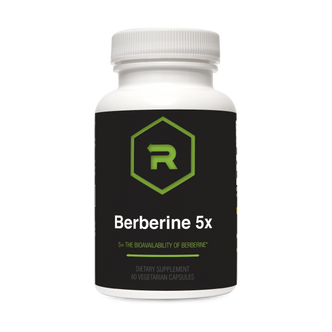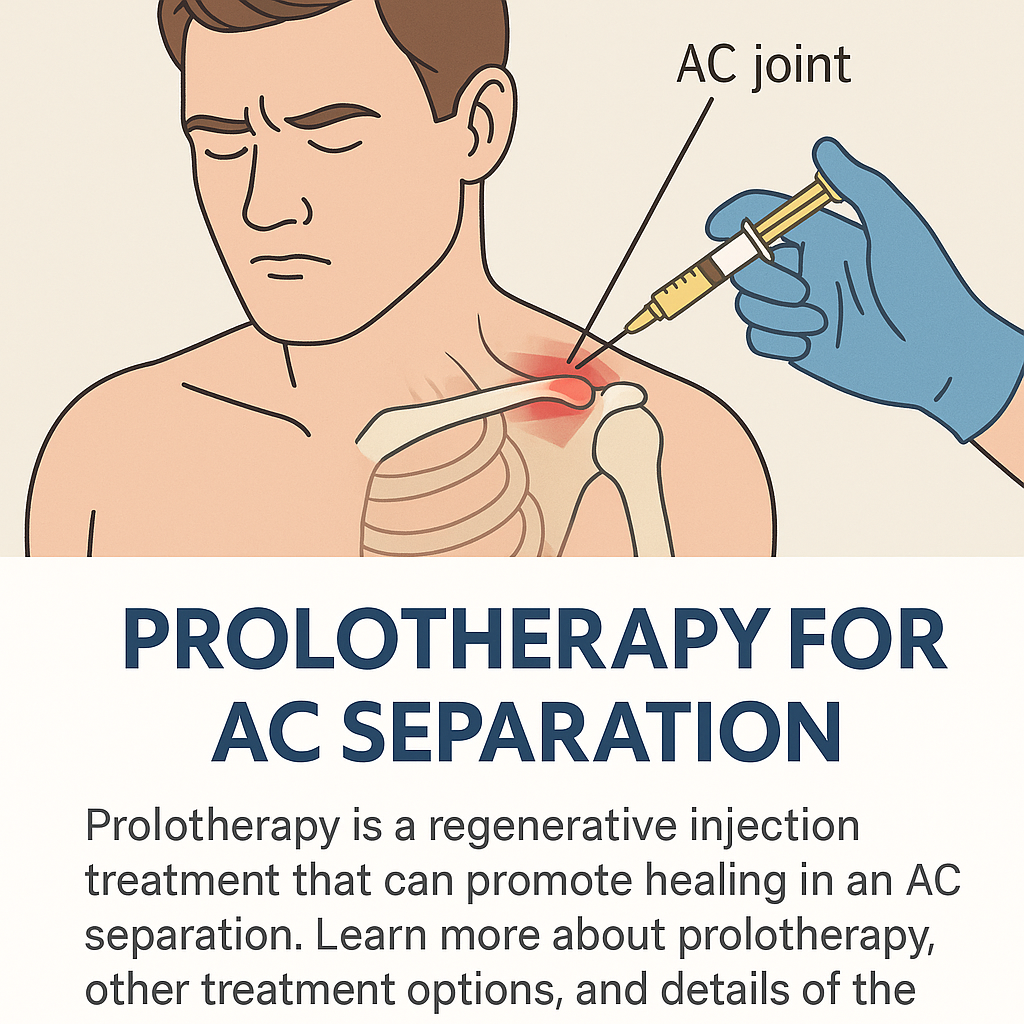Prolotherapy for AC Separation: A Regenerative Approach to Shoulder Healing
Understanding AC Joint Separation
The acromioclavicular (AC) joint is a small joint located at the top of the shoulder where the clavicle (collarbone) meets the acromion of the scapula (shoulder blade). AC separation occurs when this joint becomes dislocated, typically due to trauma such as a fall or direct blow to the shoulder. This injury is common among athletes, especially cyclists, football players, and weightlifters.
Classification of AC Separations
AC separations are classified into six types (Type I to Type VI) based on the severity of ligament damage and degree of separation:
-
Type I: Minor sprain with no displacement
-
Type II: Partial dislocation with rupture of the AC ligament
-
Type III: Complete dislocation with tearing of both AC and coracoclavicular (CC) ligaments
-
Types IV-VI: Severe dislocations involving displacement of the clavicle in various directions, typically requiring surgery
Types I to III are typically managed conservatively, whereas Types IV to VI may require surgical intervention.
Limitations of Conventional Treatment
Standard conservative management for AC joint separation includes rest, ice, immobilization with a sling, NSAIDs, and physical therapy. While these interventions can reduce inflammation and promote healing over time, they do little to stimulate true regenerative repair of damaged ligaments.
Additionally, surgical interventions often involve hardware, such as pins or plates, and carry risks including infection, stiffness, or recurrent instability. Many patients also report lingering pain and reduced shoulder function even after surgery.
This has prompted growing interest in regenerative alternatives like prolotherapy, which aims to strengthen and repair ligaments by stimulating the body's innate healing mechanisms.
What is Prolotherapy?
Prolotherapy (short for "proliferation therapy") is a regenerative injection treatment that involves injecting an irritant solution into damaged or weakened ligaments, tendons, or joints. The most commonly used solution is a hypertonic dextrose solution (15-25%) mixed with local anesthetic like lidocaine.
Mechanism of Action
The injected dextrose solution induces a mild inflammatory response at the site of injury, triggering the body to begin tissue repair. This controlled inflammation leads to:
-
Increased fibroblast activity
-
Enhanced collagen deposition
-
Strengthening of the weakened ligaments
-
Improved joint stability and function
Unlike steroid injections, which suppress inflammation and may degrade tissue over time, prolotherapy seeks to stimulate tissue regeneration.
Prolotherapy for AC Joint Separation: How It Works
In the context of AC joint separation, prolotherapy targets the damaged acromioclavicular and coracoclavicular ligaments, which are essential for maintaining clavicle stability.
By injecting the dextrose solution into the ligamentous attachments of the AC joint, prolotherapy stimulates the growth of new collagen and reinforces the structural integrity of the joint. This can result in:
-
Reduced pain
-
Enhanced joint stability
-
Improved range of motion
-
Quicker return to normal activity
Ideal Candidates for Prolotherapy
Prolotherapy is most effective in Type I to Type III AC separations, especially when:
-
Pain persists beyond 4-6 weeks of conservative care
-
There is evidence of ligament laxity or instability
-
The patient prefers a non-surgical option
-
The patient is physically active and motivated for recovery
The Prolotherapy Treatment Protocol for AC Separation
Pre-Treatment Evaluation
Prior to treatment, a comprehensive musculoskeletal exam is conducted to assess:
-
Joint instability
-
Tenderness and ligament integrity
-
Shoulder biomechanics
-
Imaging (X-ray or ultrasound) to classify injury severity
Injection Technique
-
Patient Positioning: Seated or supine with shoulder exposed
-
Site Preparation: Skin cleaned with antiseptic; local anesthetic applied
-
Injection Points: Typically include the AC joint capsule and coracoclavicular ligament attachments
-
Solution Used: 15-25% dextrose + 1% lidocaine or procaine
-
Guidance: Can be done freehand or under ultrasound guidance for precision
Post-Injection Care
-
Mild soreness or swelling is expected for 1–3 days
-
Avoid anti-inflammatory medications (they may blunt the desired response)
-
Gentle range of motion exercises encouraged
-
Physical therapy may be added at any time
Treatment Frequency
-
Prolotherapy is typically performed every 3–4 weeks
-
3–6 sessions are usually recommended depending on severity and how you are progressing
Clinical Evidence Supporting Prolotherapy for AC Joint Injury
While large randomized controlled trials are limited for AC separation specifically, prolotherapy has demonstrated efficacy in multiple musculoskeletal conditions involving ligament and joint instability:
-
Rabago et al. (2009, 2013) showed significant pain reduction and functional improvement in knee osteoarthritis with prolotherapy.
-
Hauser et al. (2016) reviewed 54 studies and found that prolotherapy consistently reduced pain and improved function in various ligament injuries.
-
Reeves et al. (1995) found increased ligamentous strength and density in animal models treated with prolotherapy.
In clinical practice, prolotherapy is widely used by regenerative medicine physicians and sports medicine specialists for shoulder instability, including:
-
AC joint separation
-
Rotator cuff tendinopathy
-
Multidirectional instability
Advantages of Prolotherapy Over Conventional Treatment
| Feature | Conventional Treatment | Prolotherapy |
|---|---|---|
| Treats root cause | No | Yes (stimulates ligament healing) |
| Reduces inflammation | Yes | Induces healing inflammation |
| Restores joint stability | Partially | Yes |
| Surgery required | Sometimes | No |
| Downtime | Variable | Minimal |
Prolotherapy empowers the body to repair itself naturally, reducing the need for prolonged medications or surgical intervention.
Additional Regenerative Options: PRP and Peptides
While prolotherapy is powerful on its own, advanced regenerative strategies can further enhance healing outcomes. Two notable adjuncts include:
Platelet-Rich Plasma (PRP)
PRP involves concentrating a patient’s own platelets and injecting them into the injured area. Platelets contain growth factors that promote:
-
Angiogenesis (formation of new blood vessels)
-
Fibroblast proliferation
-
Collagen synthesis
For AC joint injuries, PRP can be used in combination with prolotherapy or as a follow-up to accelerate healing.
Peptides
Regenerative peptides are short chains of amino acids that act as signaling molecules to promote healing and tissue repair. Peptides beneficial for ligament and joint repair include:
-
BPC-157: Accelerates soft tissue healing and reduces inflammation
-
TB-500 (Thymosin Beta-4): Enhances cell migration and regeneration
-
GHK-Cu: Promotes collagen production and reduces oxidative stress
At Revolution Health & Wellness, we offer physician-guided peptide protocols to support soft tissue recovery and enhance prolotherapy outcomes.
Patient Outcomes and Testimonials
Many patients report noticeable improvements in pain, stability, and function within a few weeks of starting prolotherapy. Athletes, in particular, appreciate the ability to return to training without surgical downtime.
Here are some common outcomes:
-
Pain reduction by 50–70% within 3–4 sessions
-
Improved shoulder stability on physical exam
-
Restoration of overhead and pushing movements
"After just two prolotherapy sessions, my AC separation pain dropped dramatically. I’m now lifting weights again without fear of instability. I wish I had known about this treatment sooner." – John R., Tulsa, OK
Why Choose Revolution Health for Prolotherapy?
Dr. Chad Edwards and the team at Revolution Health & Wellness in Tulsa, OK are experts in non-surgical orthopedic therapies, including prolotherapy, PRP, and peptide therapy. Dr. Edwards is uniquely trained in regenerative injection techniques and is committed to helping patients avoid surgery whenever possible.
We provide:
-
Advanced regenerative options under one roof
-
Personalized treatment protocols
-
Expertise in musculoskeletal and functional medicine
Whether you're an athlete with a recent AC separation or someone with lingering shoulder instability, our goal is to help you heal from the inside out.
Take the First Step Toward Healing
If you or a loved one has suffered an AC joint separation, don't assume surgery is your only option. Prolotherapy offers a powerful, evidence-based, and minimally invasive approach to ligament healing.
Contact Revolution Health & Wellness today to schedule your consultation and find out if prolotherapy is right for your shoulder injury.
References
-
Rabago D, et al. A systematic review of prolotherapy for chronic musculoskeletal pain. Clin Med Res. 2009.
-
Hauser RA, et al. A review of the clinical and basic science evidence supporting prolotherapy for ligament and tendon injuries. Open Access J Sports Med. 2016.
-
Reeves KD, et al. Evidence-based regenerative injection therapy (prolotherapy) in sports medicine. Pain Physician. 2008.
-
Lyftogt J. Prolotherapy for soft tissue injuries and arthritis: a clinical approach. Pain Med. 2005.
-
Bhatia M, et al. Role of platelet-rich plasma in the management of shoulder pathologies. World J Orthop. 2019.
-
Szykula C, et al. The use of BPC-157 in the healing of soft tissue and joint injuries: A review. J Regen Biol Med. 2021.


